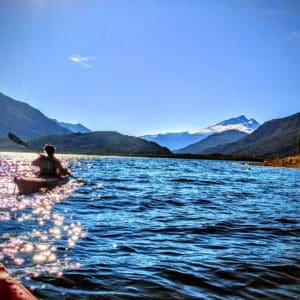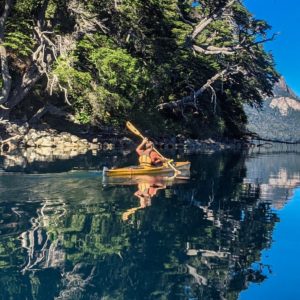With so many types of paddleboards, it can be hard to figure out how to choose a SUP (stand-up paddleboard).
Whether you want to use your board for camping, recreation, or yoga, there are several configurations for each type, and learning the differences and strengths of each design goes a long way to selecting the proper one.
In this article, we’ll discuss how to buy a paddleboard and the different types of paddleboards available.
Types of Stand-Up Paddle Boards
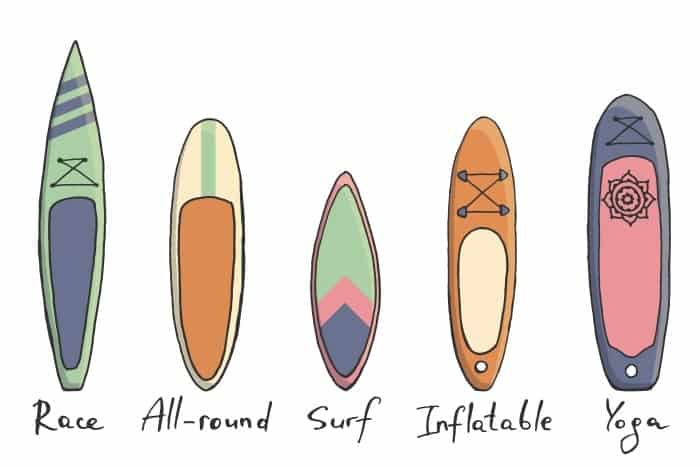
Paddleboards vary by type and activity. Some are better suited for Yoga and recreational outings, while others are meant for racing or surfing.
The main things to look for are the hull type, the construction material (inflatable, plastic, carbon fiber), and the board’s dimensions.
Hull Types
The design of your board’s hull goes a long way to determine its performance and what activity it’s best suited for. Most hulls fall into one of two categories: planing and displacement.
Planing hulls are shaped like a surfboard with a flat, wide profile. They ride on top of the water and are very maneuverable. This makes them great for beginners, recreational paddles, yoga, or whitewater.
Displacement hulls are narrower with a pointed bow similar to a kayak or canoe. Water is pushed past the bow making it more streamlined and efficient.
They require less effort to paddle with a faster top speed, and better tracking. The improved tracking and speed make them ideal for camping trips, racing, or fitness paddling.
They aren’t as maneuverable as planing hulls which makes them a poor choice for tight or crowded areas and beginners may find a steeper learning curve.
Hard-Sided Paddleboards
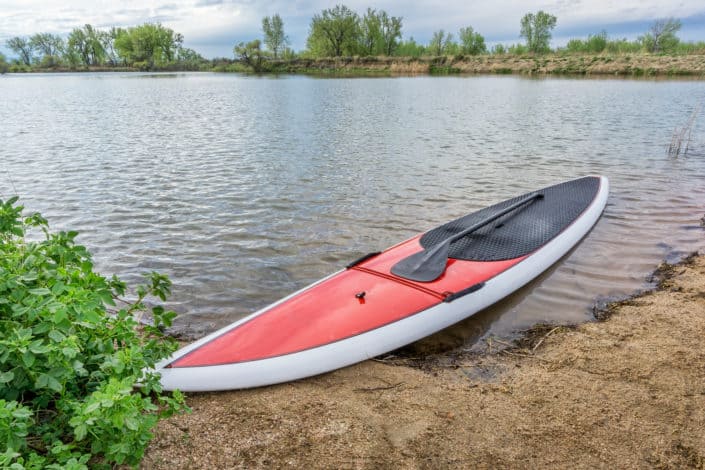
Hard-sided paddle boards can be made of several different materials.
Most have a foam core that has been covered in fiberglass and epoxy. While lighter and higher-performing, they are more expensive. Cheaper boards are made of plastic which is durable but also substantially heavier.
Solid boards provide better performance and a smoother ride than inflatables with better speed and more efficient paddling. The rigidness of the construction makes them more stable and better able to handle changing weather conditions.
More customization options are available with solid boards with a wider variety of sizes, widths, and shapes to choose from.
They are harder to store and transport since they don’t break down. You can move most boards in a vehicle via any roof rack that can house a surfboard or in the back of a truck.
In both cases, make sure that you have a method to hold it securely while driving. At home, the ideal storage space is in a dry place out of direct sunlight. Either a garage or covered shed will do fine.
Inflatable Paddleboards
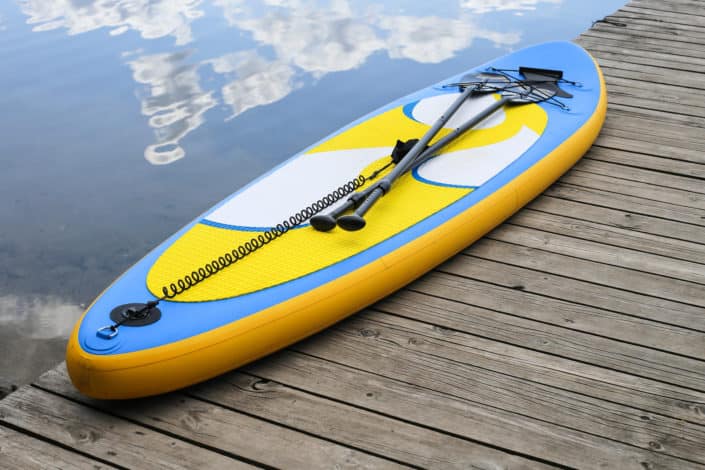
Inflatable paddleboards are popular for beginners and recreational paddleboarders thanks to their cost-effectiveness.
Most inflatables come with a carry bag and pump for easy set-up and disassembly. You need to make sure that you inflate your board properly to maintain stability. When fully inflated your board should be between 12-15 PSI.
Even if you’re an experienced paddler, an inflatable might be the best choice for you if you lack storage space for a solid board.
They’re more convenient if you’re a frequent traveler or if you want to take it backpacking.
Those looking to practice yoga on their board will appreciate the softer platform for different poses as well as those looking to do more whitewater paddling.
Paddleboard Sizing
There are several permutations for paddleboards. They can vary in length, width, volume, and included accessories.
Depending on what you want to do, tailoring your board to your exact specifications and needs will improve performance and help you get the most out of your paddle.
Volume & Weight Capacity
The amount of storage and weight a board can carry is measured in volume. This is usually listed in liters (L) on the board’s specs. The width, length, and thickness all play a factor in how much a board can carry.
Touring or multi-day boards usually have a higher capacity while boards designed for surfing and yoga have less.
A board’s weight capacity is also listed as another unit of measurement. This is expressed in pounds on the board’s specifications.
A boat’s weight capacity includes the paddler’s weight and any gear they’re carrying. Overloading a boat will cause it to sit lower in the water which reduces its speed, maneuverability, and stability.
Length
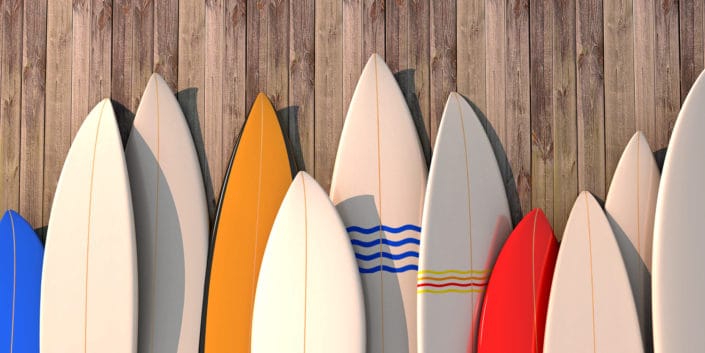
Paddleboards come in a variety of lengths with the longest being more than fourteen-feet long while shorter ones are less than ten feet.
Short boards are classified as ten-foot-long or shorter. They almost always have a planing hull and are more maneuverable than their larger counterparts. The shorter length makes them great for kids and their tight turn radius makes them ideal for surfing.
Mid-range boards are between ten and twelve feet. Most also have a planing shape though you can find a few displacement hulls. They’re the most versatile of the three categories. They rarely excel at one specific activity but are the preferred length for yoga practice or if you desire a board for all-around use.
Long boards are classified as twelve feet or longer. Less maneuverable thanks to their long hulls, they do track better and almost exclusively have displacement hulls, providing a better top speed and tracking. The extra deck length and speed makes them the preferred model for multi-day excursions and races.
Width
The proper width depends on a few factors. The wider the board, the more stable it will feel.
Shorter paddlers will prefer a narrower board since they require less room to maintain their balance.
Too wide of a board will make your paddle stroke awkward and hamper your paddling efficiency. If possible, test your board in the store before purchasing to make sure it fits you.
Tailor your board to your abilities. The more practiced and comfortable you are on the water, the narrower your board can be. If it’s your first paddleboard, it’s a good idea to select the widest design you can comfortably paddle.
Touring paddlers will lean toward a wider board in order to maximize deck space to carry camping gear.
Thickness
This refers to the vertical height of the board when it’s floating on the water. Boards are usually at least 32” thick but can be even bigger.
Thicker boards are able to handle more weight. If you plan on carrying a lot of gear or doing camping trips, a thicker board will serve you well. The same goes if you want to practice yoga as it will keep you drier.
Recreational or speed paddlers will tend to favor a thinner board to maximize efficiency and speed.
Different Types Of Fins
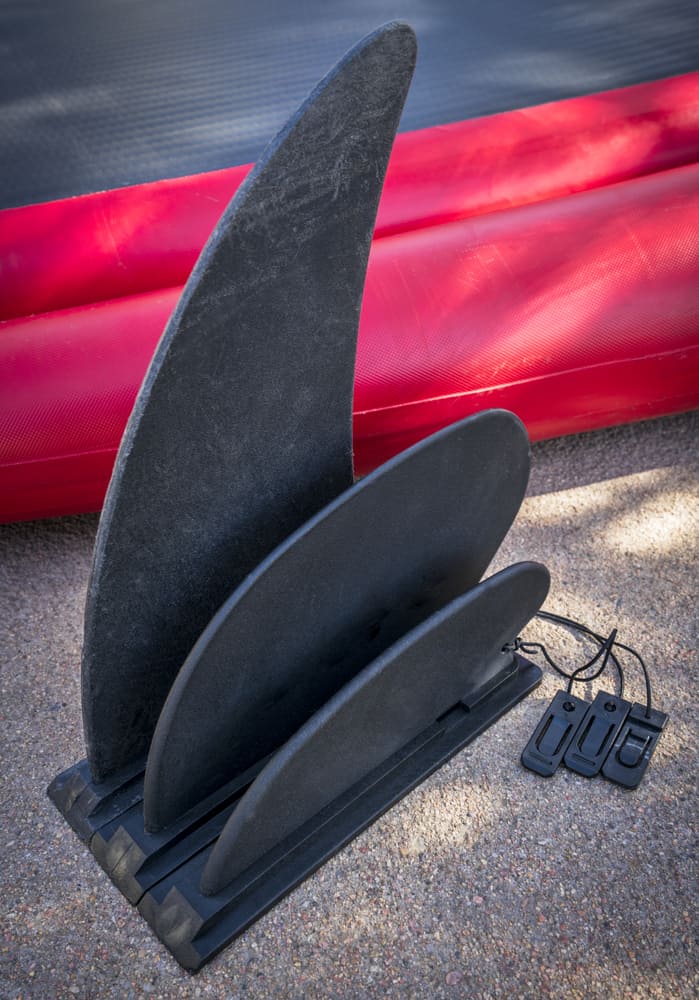
Fins add tracking and stability to your board.
There are several permutations to choose from depending on your desired activity. Common fin configurations are: single fin, 3-fin, and 2+1.
Most boards include a single fin with your purchase that fits into a slot near the stern. The single fin set-up provides good tracking while minimizing drag.
3-fin setups are known as the “thruster.” With all three fins roughly the same size, they work best for maximizing tracking on flatwater and to maintain good control in surf.
The 2+1 is another three fin model. In this case, the center fin is larger than the other two. This is another favorable set-up for surfers who don’t mind the increased drag.
Other SUP Features & Necessities
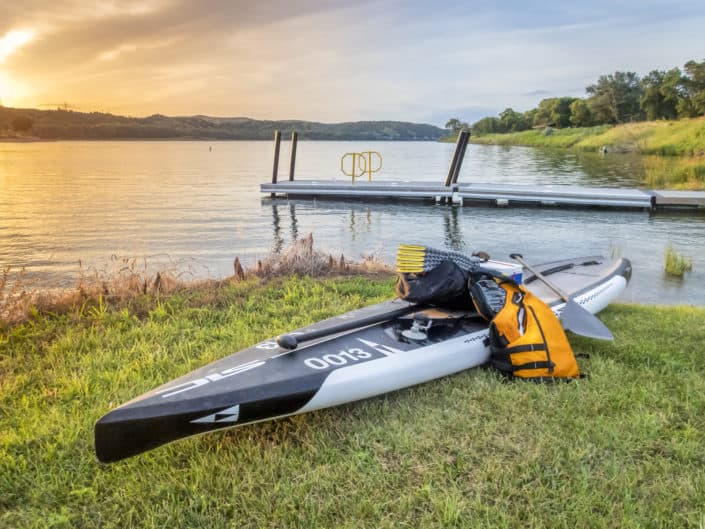
Along with your board, there are a few other accessories and safety equipment that are either mandatory or you should consider purchasing.
The most obvious one is a lifejacket (PFD). Outside of swimming and surfing areas, the U.S Coast Guard classifies paddleboards as a vessel which means you’re required to wear a PFD. Even in warm water, you should always wear a life jacket when outside of these surf areas.
Another piece of safety equipment that isn’t mandatory but can still be helpful is a paddle leash. The leash attaches around your waist like a belt and ties to your paddle. This way if you fall off your board, your paddle won’t float away. If you’re planning on doing large crossings or multi-day trips, a leash is highly recommended.
Outfit yourself in suitable clothing not just for the air temperature, but the water temperature too. In cold water conditions, a wetsuit or drysuit may be necessary. Make sure you select a wetsuit of the appropriate thickness for the water temperature.
In warmer conditions, a t-shirt and shorts or a bathing suit may be all you need. Always bring sunscreen no matter the temperature. You can get sunburned even on overcast days and being on the water magnifies the strength of the sun. Bring a long-sleeve shirt, a wide-brimmed hat, and glasses to protect yourself.
Selecting the proper paddle length for your height is key. An improperly sized paddle will make your stroke less efficient and can cause injuries over time. A quick way to measure is to set your paddle in front of you and raise your arm. If it’s the correct size, the paddle should reach to your wrist.
Many paddlers like to document their trips or record wildlife. To make it easier to bring a camera, some boards have specific mounts built into the hull. This allows you to install a GoPro, phone, or other cameras while keeping your hands free.
For transporting your paddleboard, your car will likely need some sort of roof rack. Bungee cords or ratchet straps will keep your board secure and should be considered a necessity. If you don’t have a rack, you can improvise one. Use some padding like foam blocks or wooden saddles with a towel wrapped around. Tie your board off the same way you would with a traditional rack.
Choosing Your First Paddleboard
There are paddleboards for all activities and price ranges. While the more affordable models may not be as versatile or high performing, it may be all you need if you plan on more casual or recreational activities.


Recreational and Cheaper SUPs
If you plan on paddling on lakes, ponds, and placid rivers, you are probably safe going with a cheaper board. Most of these will fall into the inflatable category which have the benefit of easy storage and transportation.
If you’d prefer a hard-sided option you can choose one made of a cheaper material like plastic. They are heavier than boards made of foam and epoxy and the extra weight can make them less efficient on the water.
For casual use, select a board with a planing hull. You won’t move as quickly but they have excellent maneuverability and stability. I’d recommend the widest boat you can comfortably paddle along with a thicker hull. This will maximize your stability and room to operate.
Best Performance SUPs
If you’re concerned with performance, you’ll probably want to be out all day or for several days paddling long distances and potentially over choppy water.
Select a higher-performing board if you plan on paddling on rough water like energetic rivers, surf, or making large water crossings with the potential for dynamic weather conditions.
A narrower boat with a displacement hull will make you more efficient and coax all the speed you can out of your board. Gaining an extra mile an hour may not sound like much, but after a few hours it adds up.
Select a boat made of lighter material. If performance is your primary interest then steer away from an inflatable in favor of a high-end model with a foam core and fiberglass exterior.
How to Choose a SUP – Conclusion
Hopefully, after reading this article you feel more comfortable navigating the diverse world of stand-up paddleboards. Selecting the proper board and being able to tailor it to the sort of activity you want to do is the key to a good paddling experience.
Do you have any questions? What are the most important characteristics you look for in a good board? Did we miss anything or do you have your own stories to share? Let us know in the comments below.

